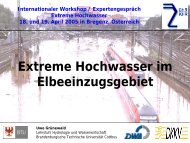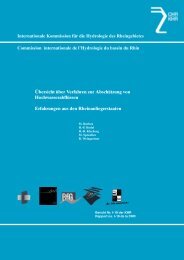ABSTRACTS 'Extreme Discharges' - CHR-KHR
ABSTRACTS 'Extreme Discharges' - CHR-KHR
ABSTRACTS 'Extreme Discharges' - CHR-KHR
You also want an ePaper? Increase the reach of your titles
YUMPU automatically turns print PDFs into web optimized ePapers that Google loves.
Large scale simulation of land use change effects on floods in<br />
the Rhine (results from the LAHOR-project)<br />
Axel Bronstert<br />
Chair for Hydrology and Climatology, University of Potsdam<br />
Postfach 601533, D-14415 Potsdam, Germany<br />
axelbron@rz.uni-potsdam.de<br />
From 1997 until 2001 an EU-funded project was conducted aiming to quantify flood risk for the Rhine basin<br />
under altered environmental conditions. The project was accomplished by Potsdam-Institute for Climate Impact<br />
Research and Univ. of Potsdam, University of Stuttgart, Bundesanstalt für Gewässerkunde and RIZA and supported<br />
by the <strong>CHR</strong><br />
The main focus of the project was on two important questions:<br />
• To what degree do changes of land-cover and river training influence the flood situation in the Rhine basin,<br />
and<br />
• To what degree can flooding be mitigated by water retention measures both in the landscape and along the<br />
river courses?<br />
Therefore the project on the one hand aimed at quantifying the impact of landscape hydrology and river network<br />
hydraulics on flooding conditions in the Rhine basin. In this context the retention capacity of the landscape with<br />
its geophysical properties and the river training conditions were of importance. On the other hand, the mitigation<br />
potential of specific measures like infiltration ponds, altered agricultural management practices, restoration<br />
measures in small tributaries and polders or flooding areas in larger rivers were investigated. The aim was to<br />
provide results which could serve as sound scientific figures about a possible increase in flood risk caused by<br />
land-use changes or a possible decrease in flood risk induced by specific measures like decentralised water retention<br />
or the flooding of polders.<br />
The project required an interdisciplinary and multi-scale approach. This was achieved by combining models for<br />
different purposes at different spatial scales, allowing the comparison of the impacts of land-cover conditions<br />
and the effects of river training activities (including the retention capacity in rivers and flood plains) on the discharge<br />
conditions in the river Rhine. The models had either to be adjusted or expanded in order to fulfil the project<br />
requirements.<br />
Special attention had to be paid to the coupling of catchment hydrology and flood wave propagation as well as<br />
to the linkage between the land-use scenarios and the structure and parameterisation of hydrological modelling.<br />
The simulations were carried out by process-oriented rainfall-runoff modelling at three different spatial scales<br />
covering the Rhine basin from Maxau (Southwest Germany) to Lobith (Dutch/German border), which is a total<br />
area of more than 110 000 km². The mentioned modifications were necessary at the following spatial scales and<br />
will be explained hereafter:<br />
1. To include process knowledge at the lower meso-scale (3 small catchments covering an area of about 100 -<br />
500 km²), which was considered to be relevant for land-use change modelling but was not represented in the<br />
original version of the chosen model. This refers in particular to the representation of macropore-effects on<br />
infiltration conditions and therefore on the possible generation of infiltration excess overland flow and to<br />
the representation of urban storm water processes, such as runoff on impervious areas, retention in sewage<br />
systems and possible transfer to sewage treatment facilities<br />
2. To transfer process knowledge (“up-scaling”) simulated at the lower meso-scale to the upper meso-scale<br />
(101 larger sub-catchments of the Rhine, ranging between 400 and 2,100 km², covering a total area of<br />
110,000 km²) where, as a consequence of data scarcity and data management constraints, a rather conceptual<br />
modelling approach had to be chosen, see below.<br />
To route the runoff from all the different sub-catchments of the Rhine catchment in the main river system. This<br />
includes possible retention effects within the river corridor and/or in flood polders along the channel system of<br />
the Rhine and its main tributaries. This is primarily a matter of hydrodynamic modelling.<br />
65





